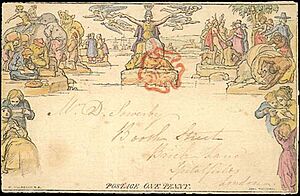Mulready stationery facts for kids
The Mulready stationery was a special type of postal stationery (like a pre-paid letter or envelope) made in Britain in 1840. It was part of big changes to the postal service. These special papers and envelopes went on sale on May 1, 1840, and could be used starting May 6. They are called "Mulready" because a famous artist named William Mulready designed the pictures on them.
What Did the Mulready Design Look Like?
The Mulready design was very detailed. In the middle at the top, it showed Britannia, a symbol of Britain, with a shield and a lion. On each side of Britannia, there were pictures representing the continents of Asia and North America. In the bottom corners, you could see people reading their mail. This design was meant to show how Britain's mail service helped countries around the world.
The artist John Thompson engraved the design. It was printed so that the picture appeared on the front of the paper when it was folded. The Mulready stationery came in two forms:
- Letter sheets: These were like regular paper that you could write on and then fold up.
- Envelopes: These started as a diamond-shaped piece of paper. You would fold the sides to the center to create an envelope, and then seal the edges.
The Mulready picture was like a fancy stamp that showed you had already paid for the postage. Just like the first postage stamps (the Penny Black and the Two Penny Blue), the Mulready letter sheets and envelopes came in one penny (black) and two penny (blue) values.
Why Did Mulready Stationery Disappear?
Rowland Hill, who helped create these postal reforms, thought the Mulready stationery would be more popular than the new postage stamps. But he was wrong! People didn't like the design very much. It was so fancy that many people made fun of it.
Some people also worried that the government was trying to control who could send letters. Because of this, many stationers (people who sold paper and envelopes) created funny drawings, called caricatures or lampoons, that made fun of the Mulready design. Their businesses were being threatened by the new government stationery.
Just six days after they were released, on May 12, Rowland Hill wrote that he thought they would need to replace the Mulready design. He said the public didn't like its "beauty."
Within two months, the decision was made to replace the Mulready stationery. It was seen as a mistake. The Mulreadys were replaced with a simpler design called the Penny Pink, which came out on February 10, 1841.
The Mulreadys were not immediately taken off sale. Post offices continued to sell them until their supplies ran out. However, many were still held by distributors. In November 1842, the government decided to officially take back all remaining Mulready stationery. This process took several years. The returned Mulreadys were stored in a warehouse. They tried to burn them, but it didn't work! Eventually, a machine was built to destroy them by punching out the center of the design. So, the Mulready stationery had a rather sad end.
The Mulready letter sheet was meant for writing directly on the inside, or for putting another letter inside. It was a bit like the aerogram letters we sometimes see today.
Back then, envelopes didn't come with glue already on them. The diamond shape of the Mulready envelope, and other similar shapes, are still used today for making envelopes.



